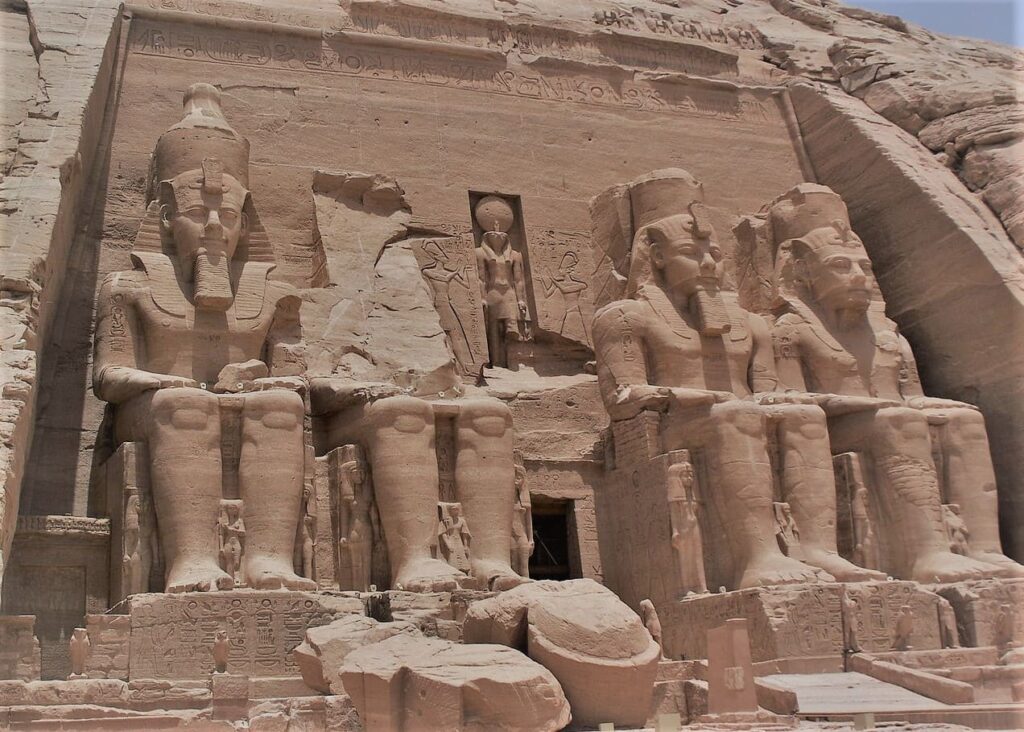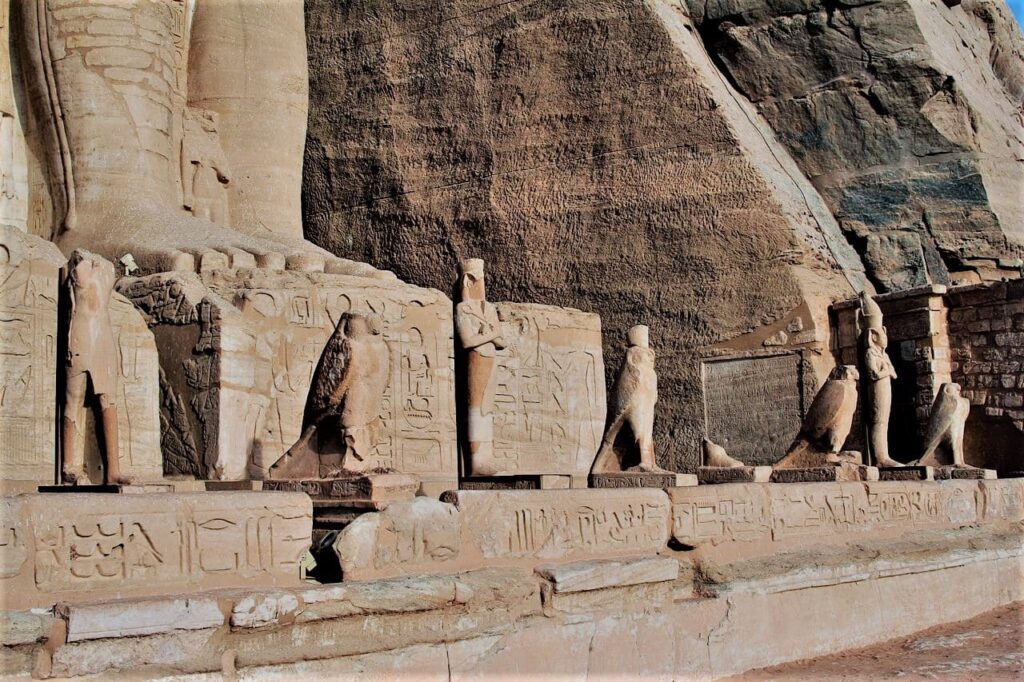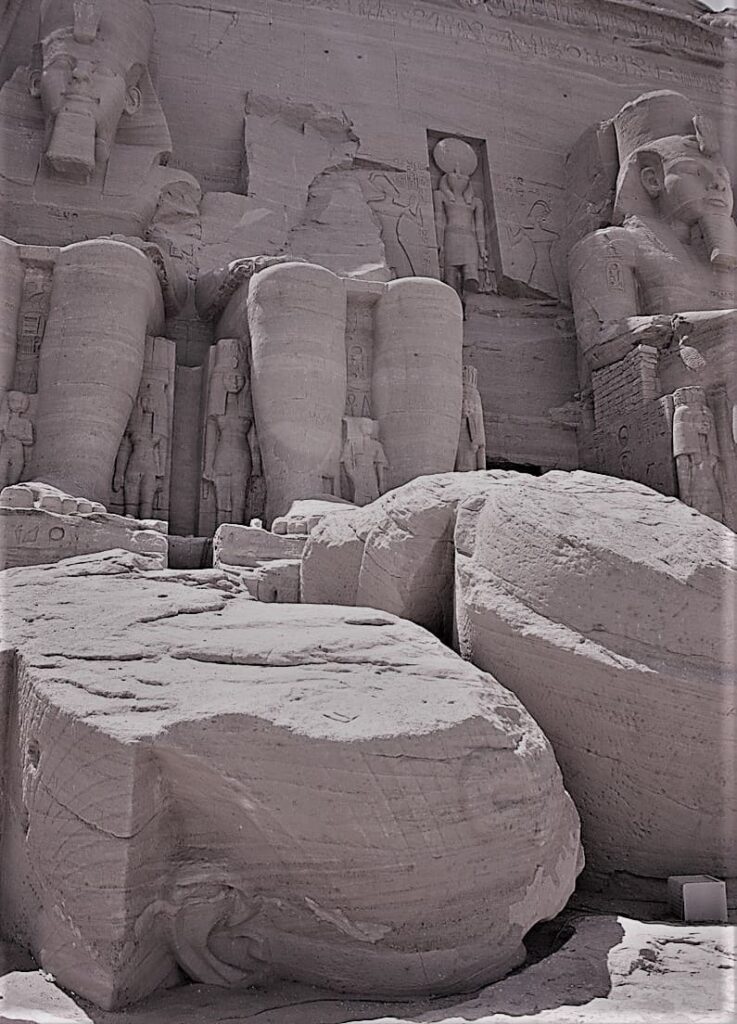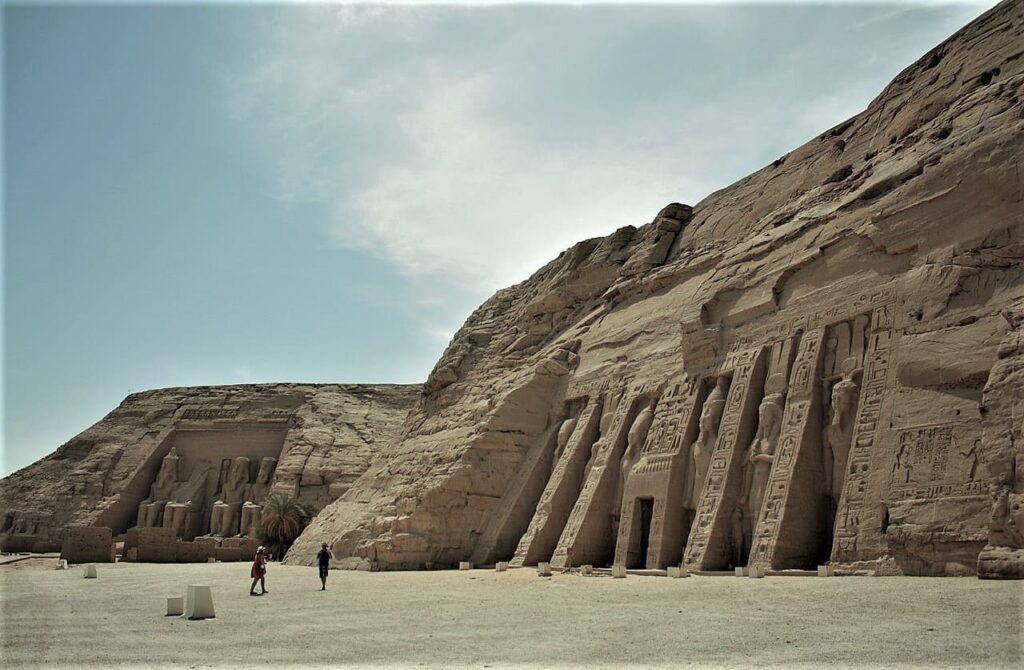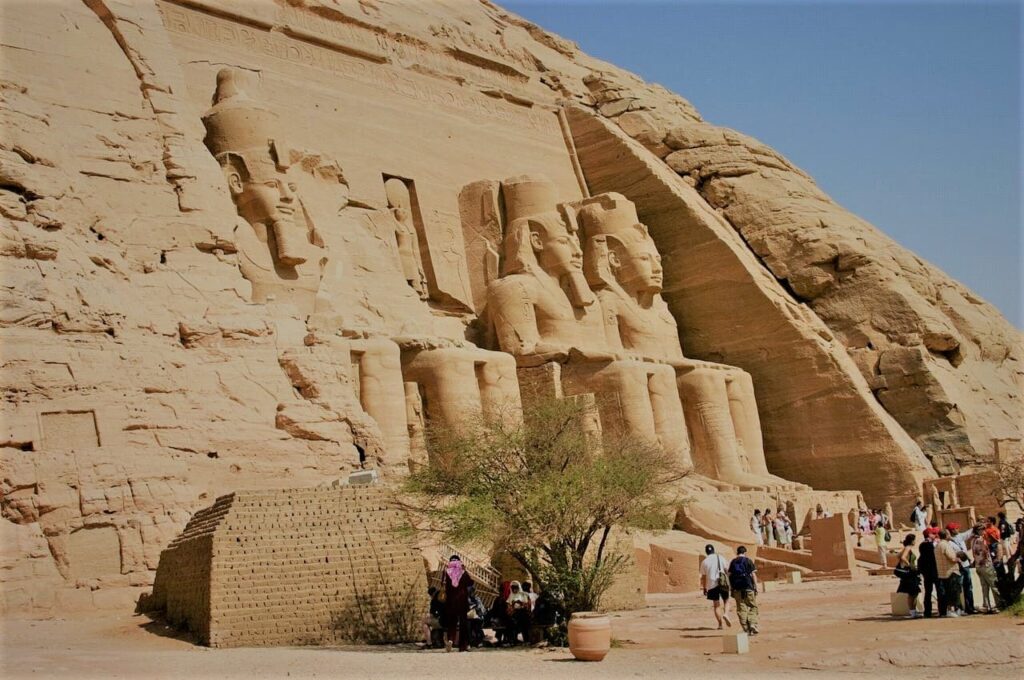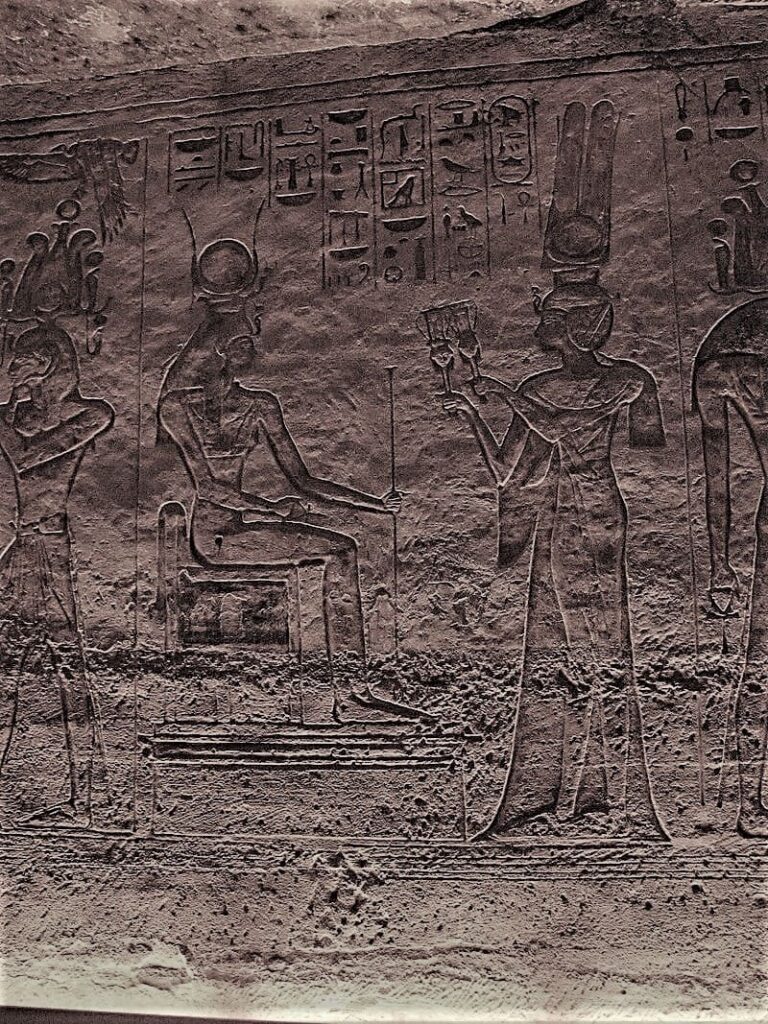
About
Near the border with Sudan, in the village of Abu Simbel (Arabic: أبوسمبل), Aswan Governorate, Upper Egypt, there is a historical site called Abu Simbel, which consists of two massive rock temples. the western shore of Lake Nasser, a 300-kilometer drive southwest of Aswan. When Ramses II in the 13th century BC. was the pharaoh of the 19th dynasty. C. the twin temples were first excavated into the mountainside. Monument to Ramses II. At his feet are his wife Nefertari and their children in reduced representations; they were not given the same prominent position.
This honors his triumph in the Kadesh War. Its huge external figures in rock relief have become famous. Led by Kazimierz Michaowski, a Polish archaeologist at the Polish Center for Mediterranean Archeology at the University of Warsaw, the complex was completely relocated in 1968 as part of the International Campaign to Save the Monuments of Nubia. It was then built on an artificial hill of a dome-shaped building that towers over the Aswan Dam reservoir.
The temples had to be relocated or else Lake Nasser, the large artificial water reservoir created after the construction of the Aswan High Dam on the Nile, would have flooded them along with other temples they extend downstream from Abu Simbel to Philae. , including Amada, Wadi es-Sebua and other Nubian sites. All the relocated temples, including the Abu Simbel complex, are part of the Nubian Monuments, a UNESCO protected site.
Construction
During his reign, Ramses II embarked on an extensive building program throughout Egypt and Nubia, which was controlled by Egypt. Nubia was important to the Egyptians because it was a source of gold and many other valuable trade goods. That is why Ramses built many great temples there to dazzle the Nubians with the power of Egypt and its destiny. The most famous temples are the rock temples near the modern city of Abu Simbel, at the second falls of the Nile, on the border between Lower Nubia and Upper Nubia. There are two temples, the Great Temple dedicated to Ramesses II himself and the Small Temple dedicated to his chief wife, Queen Nefertari.
Construction of the complex began around 1264 BC. C. and lasted about 20 years to 1244 BC. C. The «Temple of Ramses, beloved of Amun» was his name. Construction of the temple complex began around 1264 BC. 1244 BC It was known as the «Temple of Ramses beloved of Amun».
Rediscovery
The temples fell into disuse over time and were covered with sand. The sand had already in the 6th century BC. reached the knees of the statues of the main temple. C. The upper frieze of the main temple was discovered by the Swiss explorer Johann Ludwig Burckhardt in 1813, after which the temple was abandoned. Giovanni Belzoni, an Italian explorer who visited the site but was unable to excavate an entrance to the temple, heard about Burckhardt’s find and expressed interest. Belzoni tried again to break into the complex in 1817 and this time he was successful.
See Edward William Lane’s Account of Egypt for a detailed early description of the temples along with contemporary line drawings (1825-1828).
Relocation
The southernmost remains of this ancient civilization were in danger due to the rising level of the Nile that would soon be caused by the construction of the Aswan High Dam, so an international fundraiser to preserve them began in 1959. A scale model in the Nubian Museum in Aswan shows the temple’s historical and contemporary locations in relation to water levels. William MacQuitty’s concept of building a dam of clean fresh water around the temples and keeping the water level at the same level as the Nile served as inspiration for a plan to preserve the temples.
Great Temple
The Great Temple of Abu Simbel was completed around the 24th year of the reign of Ramses the Great, after approximately twenty years of construction (equivalent to 1265 BC). It was dedicated to Ramses the Deified, as well as the gods Amun, Ra-Horakhty and Ptah. It is one of the most beautiful in Egypt and is widely considered to be the largest and most magnificent of the temples built under Ramses II.
Entrance
Four massive 20m tall statues, each depicting Ramses II seated on a throne and wearing the twin crowns of Upper and Lower Egypt, flank the only entrance. Images of the king worshiping the falcon-headed Ra Horakhty, whose statue stands in a large niche, are depicted in bas-reliefs above the front door. Ra holds the hieroglyphic user, a feather, and Maat, the goddess of justice and truth, in his left hand. This is a cryptogram for Ramses II’s throne name, User-Maat-Re.
Interior
The 18 m (59 ft) long and 16.7 m (55 ft) wide hypostyle hall, also called the pronaos, is supported by eight massive Osiris columns depicting the deified Ramses speaking with the god Osiris, the god of fertility. , agriculture, the afterlife, the dead, the resurrection, life and vegetation to denote the eternal nature of the pharaoh. War scenes from Ramses’ military exploits are depicted in bas-reliefs on the pronaos walls. Four seated figures are depicted here on a black wall in these rock carvings: Ra-Horakhty, Ramses the Deified, Amun Ra and Ptah.
Small Temple
The Small Temple, also known as the Temple of Hathor and Nefertari, was built about 100 meters (330 feet) northeast of the Temple of Ramses II and was for the worship of the goddess Hathor and Ramses’ chief consort I Nefertari. This was actually the second time in ancient Egyptian history that a queen was honored with a temple. Akhenaten first honored his great royal bride Nefertiti by dedicating a temple to her, Two colossuses, separated by the huge entrance, adorn the facade carved into the rock. The statues of the king and his queen are just over 10m high.
Two sculptures of the king with the white crown from Upper Egypt stand on either side of the entrance. The double crown (the Northern Colossus) and the Southern Colossus are flanked by statues of the Queen. Surprisingly, this is one of the few examples in Egyptian art where the statues of the king and his consort are of the same size. Traditionally, statues of queens stood alongside those of the pharaoh, but were never higher than their knees. Ramses went to Abu Simbel with his wife in the 24th year of his reign.
As in the larger temple dedicated to the king, the hall of the smaller temple is supported by six pillars; In this case, however, they are not columns of Osiris depicting the king, but are decorated with scenes in which the queen plays the sistro (sacred instrument of the goddess Hathor) along with the gods Horus, Khnum, Khonsuo and Thoth and the goddesses Hathor, Isis, Maat, Ashermut, Satis and Taweret; In one scene, Ramses presents flowers or burns incense. The capitals of the columns bear the face of the goddess Hathor; This type of pillar is known as the Hathoric. The bas-reliefs in the pillared room illustrate the deification of the king, the destruction in
of his enemies to the north and south (in these scenes the king is accompanied by his wife), and the queen making sacrifices to the goddesses Hathor and Mut. The pillared room is adjoined by an anteroom, which is entered through three large doors.
On the south and north walls of this chamber are two elegant and poetic bas-reliefs of the king and his consort presenting papyrus plants to Hathor, who is represented as a cow in a ship sailing through a tangle of papyrus. On the western wall, Ramses II and Nefertari are depicted making offerings to the god Horus and the deities of the falls: Satis, Anubis and Khnum. The rock-cut sanctuary and the two side chambers connect to the transverse vestibule and are aligned with the axis of the temple. The bas-reliefs on the side walls of the small sanctuary depict scenes of offerings to various gods made by the pharaoh or the queen. Temple, there is a niche in which Hathor seems to emerge from the mountain like a divine cow: the goddess is represented as the mistress of the temple dedicated to her and Queen Nefertari, closely associated with the goddess.
-
 Excursión de 2 días a Abu Simbel267.00 €
Excursión de 2 días a Abu Simbel267.00 € -
 Paseo en faluca10.00 €
Paseo en faluca10.00 €


